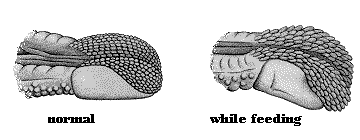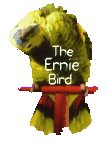
Lories have the partially deserved reputation of being messy birds. I say only partially deserved because all birds are messy. It's just a different type of mess. Seed eating parrots and finches cover the area around their cage with seed hulls and tiny feathers, African greys and cockatoos cause the surrounding furniture to become covered with a fine, white powder. Mynah birds flick bits of fruit around. Since lories have a mostly liquid and fruit diet, they consequently have liquid droppings. How much mess they make depends a lot on the individual bird. If you have one that spends a good deal of it's time sitting on a
perch, rather than hanging from the side of it's cage, then most of the mess will wind up on the floor of the cage. On the other hand, if it's one that frequents the cage sides, a good deal of the droppings will wind up outside of the cage. They can "squirt" beyond the capabilities of most seed catchers, so it's best to develop some means to protect the surrounding area. A plastic chair mat on the floor is a good start, as well as some kind of
washable protection for the walls nearby. I've seen anything from clear plastic sheeting (Visquene) to acrylic of plastic laminate panels. There are acrylic cages available, but I don't care for them. It makes a restricted bird seem all the more confined, and lories love to climb and scramble about, so a standard, high quality, parrot cage should be provided. Preferably one that is powder coted for ease of cleaning, and as large as the space you have will allow.

In an outdoor aviary they are the easiest birds to maintain, as all of their waste can simply be hosed away, no seed hulls to sweep up or sticky, green and white droppings running down the side of the cage to scrub off. Lory droppings are mostly clear or beige. A word of caution about placing lories in mixed specie aviaries. Some lories can be very aggressive toward other birds, while others will mingle just fine. The worst is probably the Chattering. They seem to take great pleasure in doing in other birds in their territory. We have bred several of the smaller species in colonies, as well as in mixed softbill flights without a problem.
Years ago, anyone keeping lories had his/her own diet that had to be made from scratch every few days at least. Most of these bordered on witchcraft, as everyone was certain that their birds just had to have this or that item included in the diet, for better or worse. Amazingly most of these "home brews" worked satisfactorily enough to keep the birds in seeming good health and even provided for some breeding. As lories became more available and popular commercial feeds were developed, first in Europe (Nekton and Biotropic) then in the US, (Lories Delight and Avico Lory Life). These brands a possibly a few others, are widely available to lory keepers and provide a couple of things that the home made diets do not. They are very simple to use, for the most part just add water (for the nectars) of provide a clean dry bowl (for the dry diets) and they were developed by professional nutritionists to provide all of the known dietary requirements. For those who still like making up their "witches brew" I suggest using one of the available lory mixes as the basis and adding fruit or vegetables to it in a blender. We feel that lories should not have an all "dry" diet. If this is the predominate factor in the diet we suggest lots of supplemental fruit and plenty of fresh water.
Lories will not do well on a diet to high in protein 15% should be the maximum. They are highly susceptible to gout and suffer kidney and liver problems as well. They should not be fed an amazon type of diet, full of legumes and such, as this is too much protein. Most any fruit is fine, but I would avoid avocado and pomegranates. We do fed the former to our softbills, but not to the parrots, and I know of three cases of lories becoming impacted on pomegranates. There are probably many who have eaten them with out a problem, but why take the chance? Lories have also been found to be susceptible to hemochromatosis (iron storage disease) and for that reason I would not offer raisins or other high iron content fruits.
We have hand reared many lories of many species and have had good results with several diets. There are certainly others besides the following, but these are the ones we can speak from experience on. Kaytee Exact (original formula) works great, and we have used it with success on many softbills as well as the parrots.
Avico Lory Life (either the Powder or the Nectar) mixed with baby applesauce (about 30%) works great as well.
Baby lories tend to cry more than other baby parrots, even when full. This should be no cause for alarm.
International Lory Society
10101A Tucker Jones RD
Riverview, FL 33569
quarterly newsletter
Lori Journal International
c/o Dr. Sam Tucker
4113 Apalogen Rd
Philadelphia, PA 19144
this is an excellent color quarterly from Europe, not to be missed.
Parrots of the World by Joseph Forshaw Landsdown, Melburne Australia 1973 other editions available
Lories and Lorikeets by Rosemary Low. Paul Elek Ltd. London England 1977 (she is working on a new version at the present time)
Australian Lorikeets by Stan Sindel. Surrey Beatty & Sons, NSW Australia 1987
Lories & Lorikeets in Aviculture by John Vanderhoof. Loriidae Production Network USA 1991
Lories are special birds for special people. If you choose to keep lories please give them the special care that they require.

